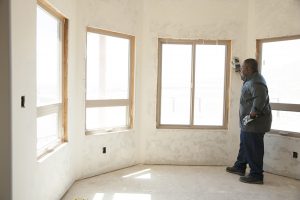

Drywall is an amazing innovation that changed the way we build structures. Because it’s so familiar and simple to work with, it’s easy to forget that there are hazards associated with its installation that could cause significant injuries.
OSHA studies have determined that injuries caused by overexertion and falls are the two major hazards that workers face with working with drywall. These injuries account for two-thirds of all injuries associated with drywall. Often overexertion is a result of carrying, lifting, or holding drywall and back injuries are common.

Depending on the size of the drywall, it can weigh anywhere from 55 to 120 pounds. While most workers are not intimidated by that weight, the repetitive nature of the work can lead to issues that result from lifting, bending, or twisting. These motions create stress on the back, legs, hips, and shoulders.
In addition, holding drywall up for long periods of time can cause muscle strains in the arms, neck, and shoulder muscles.
How can you avoid injuries?
As with all things in the contractor world, planning is the best way to avoid injuries. Ask the deliverers to place the drywall as close to the worksite as possible to reduce the need for lifting. In addition, always work in pairs when lifting sheets and putting them into place.
Workers should also ensure they have protective attire such as safety shoes, gloves with PVC dots, and eyewear.
Drywall can generate a lot of dust when it’s being moved or cut. So does drywall “mud” when it comes time to sanding.
It’s vital to check the Safety Data Sheets (SDS) to determine what the drywall is made of in order to ensure the proper safety attire. Depending on the manufacturing material, you many to wear safety goggles, respirators, and long-sleeved clothing to avoid irritating your lungs, eyes, and skin.
Proper ventilation is always important to help limit the exposure to drywall dust and prevent it from traveling to other areas where it’s not wanted. Ventilation is extremely important when working on renovations or expansions of occupied spaces.
When hanging drywall and cutting opening for electrical boxes and switches, it’s important to know what is behind or adjacent to the wall. It’s important to know where electrical wires or plumbing is located when nailing or screwing in drywall. The same holds true when tearing down drywall as well.
Even though drywalling is familiar, things can change from one job site to another. Planning, preparing, and maintaining awareness is vital to reducing hazards that can have a short or long-term impact on worker health.